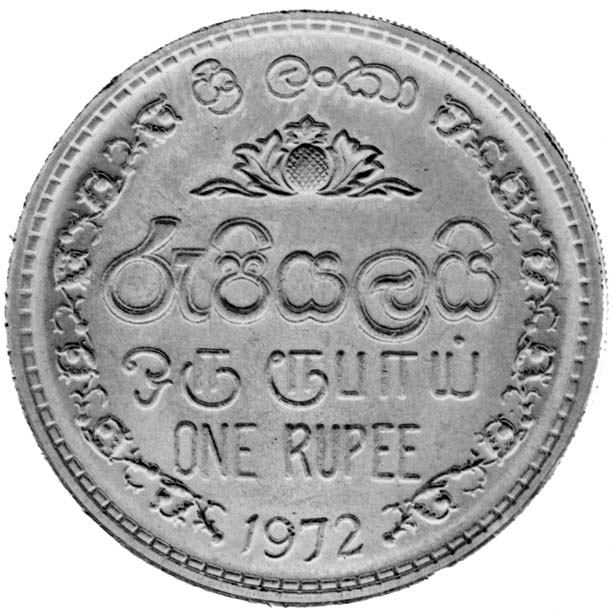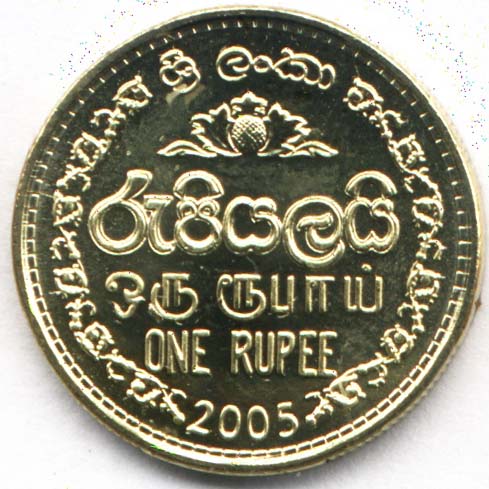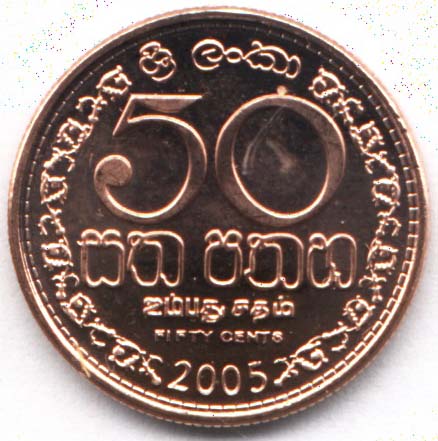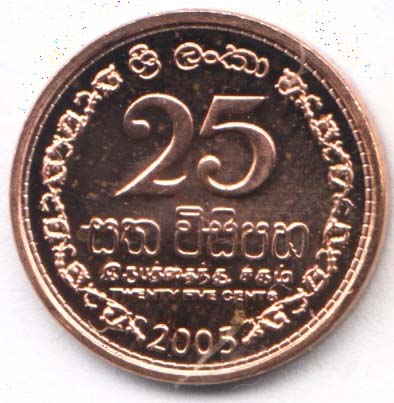The diameter of these low denomination coins have reduced by about 20% and the weight by about 50%.
The smaller aluminum 1, 2, 5, and 10 cents denominations will not be issued.
They were last minted over 10 years ago in 1994, 1978, 1991 and 1991 respectively.
Although still legal tender they are hardly seen in circulation and rarely issued by the Central Bank since the cost of minting them and even the scrap value of aluminum far exceed the face value.
It is rarely that any country changes the size or shape of currency in circulation.
Most denominations have had a changes to cheaper metals and became lighter, some were demonetized and withdrawn from circulation but the size and shape remained the same.
Though the Central Bank has over the years issued commemorative coins of varied size and shapes, there have been only only three other significant changes in the size or shape of a coin since decimal currency was first issued for Ceylon back in 1870.
The Queen Victoria copper round 5 cent penny size coin 34 mm in diameter and 18.9 grams in weight was demonetized effective 1910 July 1st and replaced in 1909 with a much smaller square cupro-nickel 18.5 mm in width, 3.88 gram coin.
During WWII the George the Sixth silver round 10 cent coin 15.5 mm in diameter and
1.116 gram in weight was demonetized effective 1943 February 28th and replaced in 1944 with a 6 scallop nickel-brass 23.1 mm in diameter and 4.21 gram coin.
The George the Sixth copper round 1 cent coin 22.5 mm in diameter and
2.362 gram in weight was removed from circulation an replaced in 1963 with aluminum cent
16 mm in diameter and 0.70 gram coin.
Inflation causes the value of the Lankan rupee to go down by a factor of 10 about every 22 years. i.e. a factor of a 1000 in 66 years. For example in the early 1940s a gold sovereign was worth about Rs. 13 and now it is over Rs. 13,000/-. When the quarter cent was demonetized in 1910 and the half cent in 1941 they were worth about 5 current rupees.
Practically all items are now priced in whole rupees so the new 25 cent and 50 cent coins have been issued long after they should have been removed from circulation. One rarely sees fractional rupee coins in circulation in Lanka since even bus fares use whole rupee prices. Change of even a Rupee is not often returned and ignored. Fractions of Rupee are now hardly of any value and even a beggar will probably scold you if you toss him a coin of lesser value.
As the cost of minting Lankan coins is now much higher than their face value, it is probably
time now to get rid of all cents coins in Lanka.
The difference between the face value of coins and the local value of the
metal they contained plus the cost of minting the coins is known as
seignorage and represents the profit or loss to the Bank issuing the coins.
Until just before WWII the face value of coins was only slightly
more then the local value of the metal they contained. The difference paid
for the cost of minting the coin. Copper coins were large and heavy.
In Ceylon Denominations above 10 cents were minted in Silver. To
simplify physical transport of large amounts of money, currency notes
were issued with a Promise to pay the bearer on demand with
reserve gold and silver stocks held in the Bank.
In 1941 during WWII after the Ceylon Government was no longer able to
back the currency it printed with silver or gold. The statement of
currency notes change to say they were legal tender for the payment of any
amount, and the Silver coins were demonetized and replaced first with
fractional paper currency notes legal tender for payment of a sum not
exceeding Five Rupees and then later with Brass coins.
As the value of Brass in the coins which were introduced
during WWII cost more than face value, they were replaced first by
Aluminum and Cupro-Nickel in 1963, and 1978, and more recently in
1996 by nickel plated steel.
Coins last 10 times longer than currency notes which in few years gets
dirty and torn and needs to be replaced. If most coins returned to the
Bank, then their would be no need to mint more of them. However very
many of them get saved in large hoards in boxes that collect
offering at places of religious worship, or even in the homes of the
public who see little value in returning them.
A newspaper advertisement by CBSL on 2005 January 2nd, called for
Expression of Interest for minting and supply of Sri Lanka Coins.
The tender to mint the Rs. 427.5 Million of 2005 coins
was awarded again to the Royal Mint in UK which has minted most
of the Sri Lanka coins since 1959.
With Electronic transfers for many transactions we are heading
toward a coin and currency less society. However that is in the distant
third world future.
Author maintains an educational website on two thousand years of
Lankan coins at
http://coins.lakdiva.org.lk/, and is a life member of
the Sri Lanka Numismatic Society.
This text is a copy of Changing Faces By Kavan Ratnatunga which
appeared in the SundayTimes of Sri Lanka on 2005 December 18th.
The eEdition online
doesn't have the Plus 2 section of the printed copy.
My original article
New Coin types for Lanka
was edited above to match more closely the printed version.
I however changed for example the title of this online version to
Changing Sizes since the face of the coins did not change.
In late January 2005, a few weeks after the CBSL Advertisment calling for
expression of interest in minting of 2005 coins I sent my
recomendations to the CBSL Currency Department.
Other Press Reports online.
The coins were first announced on Television News on 2005 December 13th being
shown to President Mahinda Rajapakse, who had then released the news to the
media. Specimens of these new coins had been available at least since late October long before the election of the President on 2005 November 17th.
The 5 uncirculated Sri Lankans coins sealed within a Foreign plastic pack
designed for 10 coins as seen above in the hand of Assistant Governor
Rose Cooray was packed by Royal Mint for educational use.
|
The Rupee, 50 cents and 25 cents coins were first issued from the CBSL cash
counter at 1:30 PM on 2005 December 14th after the CBSL Press conference that morning. This limited issue was on orders of the Governor of the Central Bank of Sri Lanka. The release was not preannounced. The Security at CBSL cash Counter did not know just 15 minutes before the release. The coins of the three denominations were hand counted from three plastic bags and released to the few persons including myself in the queue that soon formed, since it was a very slow process.
Each of the Mint sealed Plastic bags had Rs1000/- worth of coins for the cent values and 1000 coins for the rupee denominations. i.e. 4000 25c; 2000 50c; and 1000 each for Rs1, Rs2 and Rs5 coins. A small white paper tag pasted outside the bag has the date and time of packaging as well as the checked weight. All of the datesI saw are in early 2005 October, a few weeks before I saw samples at CBSL.
| 
Author at CBSL counter
AFP |
I got a copy of the Official CBSL Press Release and affixed Rupee, 50 cents and 25 cents stamps on it and had it postmarked at the Philatelic Bureau on the day of the issue to create a unique souvenir. The 25 cent Stamp which is no longer issued was difficult to obtain.
The Rupees 2 coin was issued on 2005 December 22nd. The CBSL cash counter was still hand counting and releasing a limited Rs50/- worth to each person in the short queue. Mostly bank employees since the public need an appointment to get into the bank. Larger orders they requested we obtain from the commercial Banks.
Note that the hand counting leaves finger prints on many coins which stained along the print in few days. I found a brass plated 25c coin I carried in loose change in pocket had corrosion spots.
Probably to minimise cost the quality of production has been cheap. See note of error coins.
According to a statement reported to have been made at the Press Conference
The lower denomination coin are popularly used as washers after drilling a
hole in the middle
This is probably an age old practice and I have seen examples of Coffee
Tokens with a drilled hole used as Tags. It probably explains some of the
damage seen on old copper dumps.
while some five rupee coins are smuggled to London where vending machines
can be fooled into accepting it as a one pound coin.
The British Pound is 9.5 grams and 22.5 mm in diameter. The Lankan Rs5 coin
is 23.5 mm in diameter and was of the same weight, which is probably why the
new issue at 7.7 grams is 19% lighter. That is probably sufficiently lighter
for coin machines to identify it as not a pound. If the Rs5/- coin was shaved
to the diameter of the British Pound it is only 8.33% lighter.







